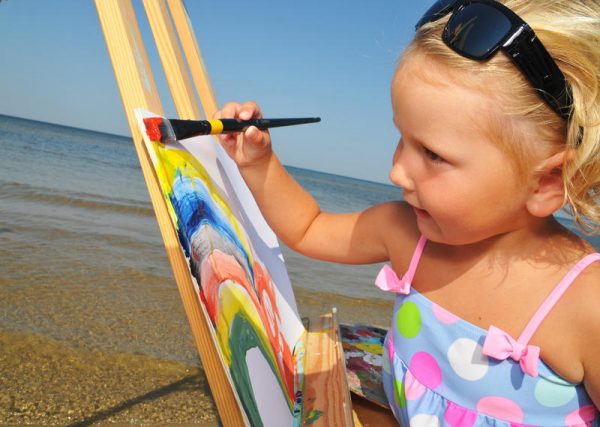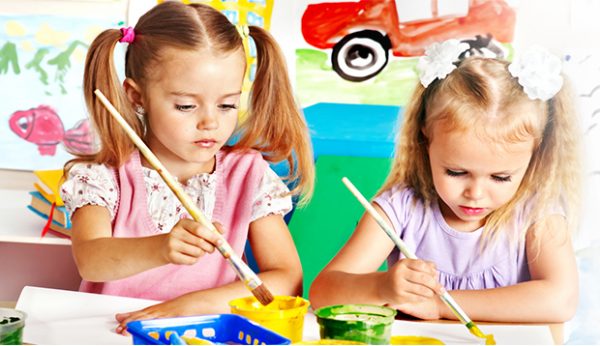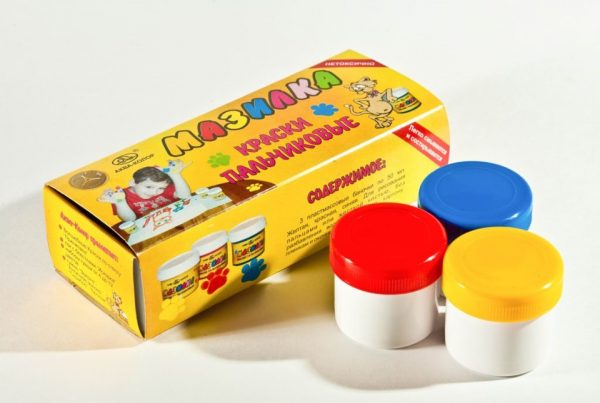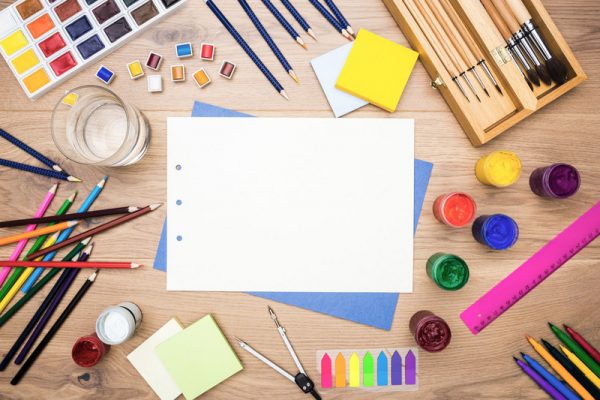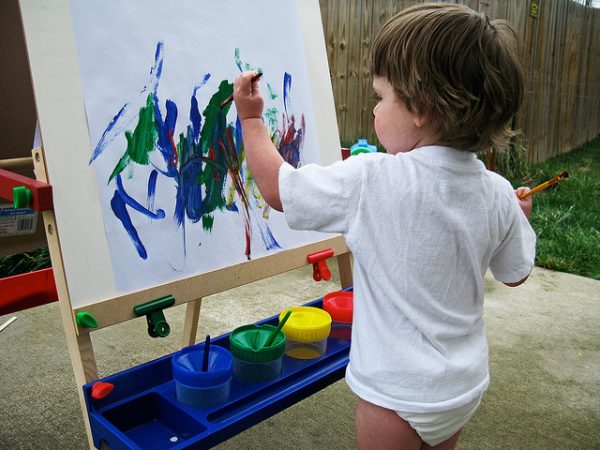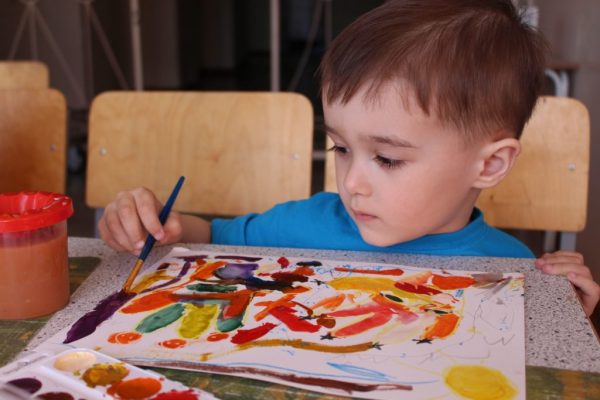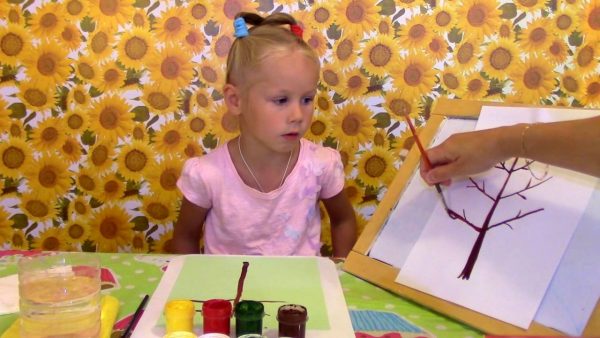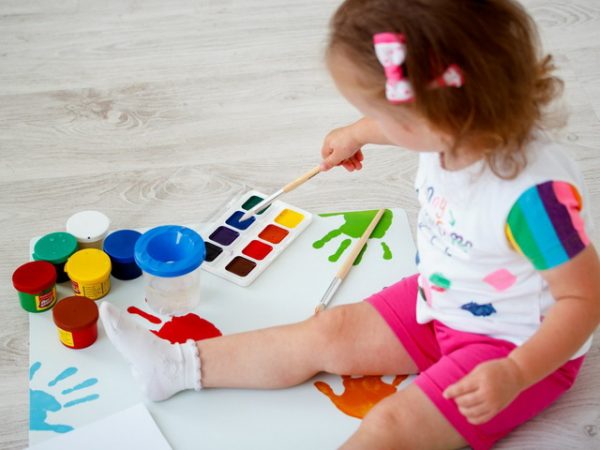Children's creativity is an important stage in development. A particularly interesting type of applied art is painting, which attracts all kids from a very young age. Paints for children are incredibly useful, they form personal qualities, develop imagination.
- The benefits of drawing for children
- Age to start drawing
- What colors are suitable - the choice of material for children's creativity
- Start drawing - selection of drawings
- Other drawing supplies
- Drawing lessons from 2 years
- 3-4 year drawing
- Drawing lessons from 4 years
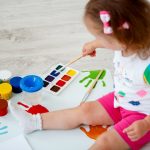
The benefits of drawing for children
Why do all educators and psychologists recommend starting painting with children as early as possible? To teach the kid to draw is really important. For children of early and preschool age, creativity is useful for such reasons:
- stimulates fine motor skills and logic;
- develops speech;
- helps formulate thoughts, suggestions;
- improves self-expression function;
- promotes self-affirmation;
- teaches adoption of non-standard decisions;
- develops memory and attention;
- helps to improve hard work, perseverance.
The drawing process for children 2-3 years old and even younger will give a lot of joyful emotions, help diagnose various problems - medical, psychological. Drawing fights with complexes, isolation, self-doubt. Also, this art lays the aesthetic perception of the world and from an early age reveals the creative inclinations of the child. Drawing with parents is an occasion for additional joint stay and entertainment.
to contents ↑Age to start drawing
The need to draw in a child may arise already at a young age - at 1 year or a little later. Most babies clearly see a craving for bright colors, a desire to portray something on paper by 1.5-2 years. Of course, the first drawings are painted spots, but the child is working more and more actively each time. Also often his "talents" become noticeable on furniture, walls, wallpapers, but psychologists do not recommend strongly scolding a child for this, so as not to discourage the desire to create.
By about 4-5 years old, children can already begin to attend drawing lessons, if there is a desire and inclination. You can learn to draw beautiful pictures at home, studying with your parents. On the Internet there are many useful workshops, thematic information. Children 7-8 years old and older can attend classes at the school drawing group, where they will be told about the basics of painting and taught many interesting things.
to contents ↑What colors are suitable - the choice of material for children's creativity
For young children, it is recommended to choose finger paints, ideal for drawing with fingers, palms. They can also be used later by applying a brush.
For drawing by children from 4 years old it is already possible to get gouache. For beginners, these paints are great. Their density allows you to sequentially impose colored layers, paint over damaged fragments. Usually, for coloring or drawing pictures in an album, a set of 6 colors is enough, from which you can get many new shades. Older children are better off buying larger sets - 10 colors or more. From the age of 6, you can already switch to watercolor paints, and at 7-9 you can use acrylic dyes for creativity (for example, for drawing on foil, fabric).
to contents ↑Start drawing - selection of drawings
In drawing, you need to act in stages - move from easy to complex. Mom can give her “drawing lessons” to the baby as soon as he is able to hold various objects with his hands. At first, it is advisable to offer the child a pencil, having previously shown how to draw lines on paper. Having understood the meaning of the work, the baby will be interested in it.
From the age of 1.5, the child can already perform the simplest drawings - dashes, the likeness of figures. Gradually, tasks and goals become more complicated, but they do not impose strict requirements on the baby. On the contrary, it is desirable that he undergo a “phase of marasmus,” which ends around two years of age. Further recommendations for creating drawings will be as follows:
- 2-3 years - initial skills of working with a brush, drawing flowers, geometric shapes, first snow, etc .;
- 4-5 years - painting, shading, work with pencils, brush;
- 6-7 years and older - drawing compositions, landscape paintings, forests, animals, the study of portraiture.
to contents ↑
Other drawing supplies
No less careful attention than paints should be given to the choice of brush. Her handle should be reliable, better from strong plastic, so as not to break. The iron capsule must be smooth so that the child does not scratch the skin. The diameter of the brush is the same as a regular pen. Children are well suited for bristle brushes, which do not strongly absorb paint, make smooth strokes. The length of the brush should be such as not to touch the face of the child.
A list of what else might be required for drawing:
- Felt-tip pens. They are bright, allow you to complete a beautiful drawing quickly, without effort. Some markers are blown out on paper in the form of a “colored rain”.
- Pencils. Less bright, but their hands do not get dirty.
- Crayons. Indispensable for drawing on asphalt. The size of the crayons should be large so that the child does not damage the skin on the asphalt. They can also be drawn on the blackboard at home.
- Wax crayons. Well suited for painting shapes inside the outline.
- Paper. The A3 format is ideal for kids; older children buy standard A4 albums.
- A simple pencil. Helps create basic contours. It is better to take a pencil marked HB, it does not crumble.
- Eraser. An important tool that allows you to erase incorrectly drawn contours, details.
- Pencil sharpener. It’s better to buy a good one right away, because cheap ones quickly fail.
- Bank for water. An ordinary glass is also suitable, in which it is convenient to rinse the brush.
Drawing lessons from 2 years
Before starting the lesson, it is important to make sure that the child’s workplace is well lit. He should get all the accessories without getting up from his chair. It is better to cover the table with a thick oilcloth, which is easy to wash, because children at this age are very dirty in the classroom.
To start the first lesson is with finger technology. Description of the process step by step:
- Mom or another adult dips his finger in the paint, puts a print on it or runs it on paper. Literally 1-2 strokes are enough.
- You need to invite the child to do the same. You can take one of his fingers, moisten with paint, put a speck.
- It is recommended to help the child draw a light picture with his finger - a petal, a caterpillar. You can make the sun with the rays.
Then you can deal with the baby as much as possible, allowing him to draw drawings independently and with the help of adults. Do not give paint in a large container, enough small jars so that the whole hand does not fit in them. The best option is to buy a special kit specifically for a given age.
Closer to 2.5-3 years, you can already learn other artistic techniques. For example, the "blot" technique is performed as follows:
- Mom bends the sheet in half, on one side draws any picture in gouache, for example, the wing of a butterfly;
- tightly presses the halves of the sheet against each other, allowing the wing to print on the clean side;
- helps the child to do the same actions by drawing a blot, figure, leaf, flower and other pictures.
By the age of three, the baby usually gets around the stencils that you can buy, print from the Internet. They can be left in the form of contours of the drawing, painted over, shaded.The easiest way to start is with stencils of geometric shapes - circles, squares, triangles. Also at this age, you can make fingerprints of the entire palm by painting it with gouache. Mom should show how real pictures are made from a series of such prints - bouquets, the sun, trees, etc.
to contents ↑3-4 year drawing
At this age, you can begin to master new techniques and gradually accustom the baby to the implementation of these gouache drawings. Here are a few creative ways:
- adjoining - to put with a brush light spots from which the image is formed;
- strokes - with the help of lines made in different directions, they also get original drawings;
- drops - you can dip the brush in the paint, let it drip onto the paper, then form bizarre patterns;
- wet drawing - slightly moisten the sheet, drip the paint, see how it spreads on paper;
- sketches - by the age of 4 you should try to draw them with a simple pencil, after shading them, painting over them;
- girls, boys from figures - you need to show the child how the outlines of a person are obtained from the simplest contours.
Also, a child in 3-4 years is entrusted with the work with a sponge. You can even put colorful fingerprints on the paper with your fingers, palms, and then make smears with a sponge to give the picture a finished look. At 3-4 years, it is enough to draw three times a week for 10-20 minutes. This will eliminate the satiation of this occupation, but will not allow him to abandon.
to contents ↑Drawing lessons from 4 years
As they grow older, the child already draws more complex pictures - autumn or winter, the underwater world and space, of course, based on his vision. Initially, the results can be angular, spreading, but at 5-6 years old, children who began to train at a young age usually draw such pictures well. It is very important to talk with children about their work - what is depicted, what characters, what they do, etc. It is imperative to keep the baby’s work, this will give him confidence in the importance of his work.
A popular pattern in 4-5 years old is an autumn tree or a winter Christmas tree. The technique of drawing a Christmas tree is as follows:
- execute a vertical line;
- draw slightly curved lines - branches;
- outline the branches with green needles, making them fluffy;
- draw the trunk brown;
- after drying among greens make marks with white paint.
It is also recommended to draw a hedgehog with the child, the work will take a maximum of 12-13 minutes. First, the body of the hedgehog is marked with a pencil in zigzags, then the ears are added, the oval with a sharp nose - the head. The legs are drawn below. After that, you can do finer work - make eyes, nose, mouth, color the hedgehog with colored pencils and paints.
Also, children love to draw an owl, a donkey, cats and dogs. As a basis, you can take geometric shapes, to which paws and tails are attached. It will be easy to draw a person - a circle, ovals and elongated rectangles are enough. Children from 7-10 years old, if they wish, can try themselves in portraits, still lifes and other complex drawings. If there is a need and ability, it is necessary to send the child to specialized training, where his talents will be fully manifested.

